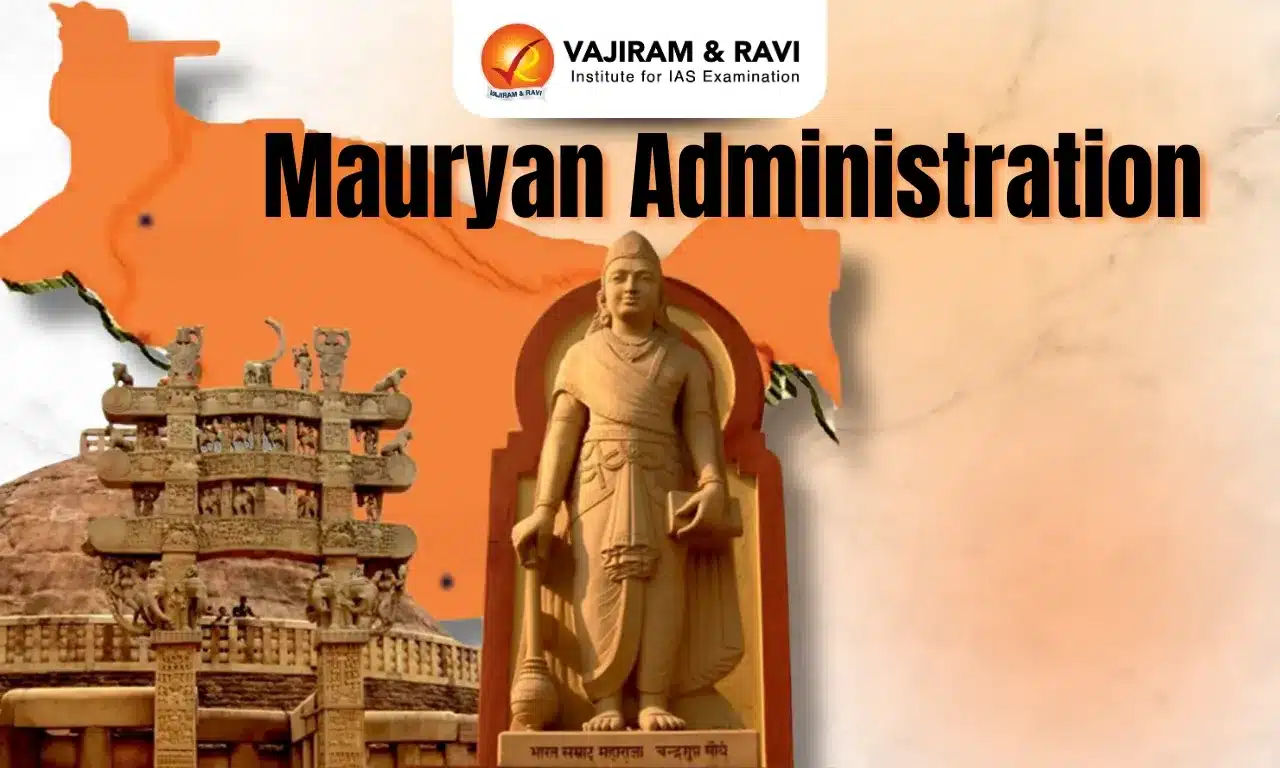The Mauryan Administration system, detailed in the Arthashastra, Greek accounts, and Ashokan inscriptions, demonstrated a centralized and efficient bureaucratic framework. Under the leadership of Chandragupta Maurya, Bindusara, and Ashoka, it emphasized welfare and justice, marking the beginning of political unity and administrative uniformity in Indian history. This system set the stage for a cohesive empire, fostering stability and effective governance.
The Mauryan empire was divided into provinces, each governed by a prince or a royal family member to ensure efficient control. During Ashoka’s reign, the empire was formally divided into five parts, with Magadha and its neighbouring Mahajanapadas directly managed by the central authority. This structure strengthened administrative efficiency and consolidated power.
Mauryan Administrative System
Mauryans developed an organized and elaborate system of administration. Decentralization was prevalent, as the village units played a significant role as the base of grassroots administration.
- Division of Mauryan Empire: The empire was divided into provinces, provinces into districts, and districts into rural and urban centers for efficient administration.
- Saptanga theory of State: Kautilya enumerated and clarified seven Angas, Prakritis, or elements for describing “the nature of the State” in its entirety. These are:
- Swami (Sovereign King): The Swami is the chief executive head of the state and is, thus, “the consummation of all other elements”.
- Amatya (Minister): Kautilya describes an elaborate system of recruitment of the Amatyas and other officials who were morally and ethically pure, honest in financial matters, and of good character.
- Janapada (People and Territory): This distinctive Saptanga feature is the State’s symbol, representing a “territorial society.” Kautilya’s Janapada encompasses both territory and population.
- Durga (Fortification): Kautilya regarded fortification as essential for the defence and protection of the state. He desired that the state fortify the territories on all sides.
- Kosha (Treasury): Kautilya desired a prosperous treasury, and he specifically directed the king to obtain the nation’s wealth only through legitimate and righteous means, rather than unfair and immoral means.
- Danda (Army or Force): He accepted a strong and hereditary Kshatriya army as the most important requisite of the state.
- Mitra (Allies): Kautilya considered the Mitra or the Ally a vital factor. Kautilya recognizes two kinds of allies, namely Sahaja and Kritrima.
Mauryan Administration Central
The Mauryan central administration was marked by strong centralization, with the King as the supreme sovereign holding executive, legislative, and judicial powers. Supported by a Council of Ministers and a structured bureaucracy, the administration ensured efficient governance and cohesion across the vast empire.
- Powers of King: He had his supreme executive, legislative, and judicial powers vested.
- Appointment: He appointed ministers and other royal administration officers.
- Supreme Commander: He was the army’s supreme commander and oversaw the entire military.
- Hindu State Before Ashoka: The Mauryan Empire was essentially a Hindu state before Ashoka’s reign.
- Dharma as Supreme Sovereign: According to Hindu principles, ‘Dharma’ or law was the supreme sovereign, and the King served as its guardian.
- Role of Mantri Parishad: The King was aided and advised by a Council of Ministers, which guided him in day-to-day administration.
- Influence of Brahmins: The Brahmins significantly influenced the King, who could not disobey them.
- Decentralization: The Mauryan government’s powers were decentralized; the provincial governor and ministers had the right to be consulted by the King, particularly on all provincial matters.
- Bureaucracy: A well-organized hierarchy of bureaucrats looked after the executive, judicial, and revenue offices.
- Departmental Structure: The entire administration system was divided into departments, each headed by a Superintendent known as an ‘Adhyaksha.’ Clerks, accountants, and spies assisted the Adhyaksha.
- Other Key Officers: Besides, there were other officers like the Army Minister, Chief Priest, and Governor of Forts.
Mauryan Administration Provincial
The Mauryan provincial administration was designed to ensure effective governance across the vast empire, blending central oversight with localized autonomy. The division of the empire into provinces, districts, and smaller units enabled efficient administration and streamlined operations.
- Division of the Empire: The empire was divided into two parts: the King’s direct rule and vassal states.
- King’s Territory: The King’s territory consisted of several provinces called ‘Janapadas,’ governed directly by the Mauryan administration.
- Provinces under Ashoka: Ashoka’s empire had five provinces with capitals at Taxila, Ujjain, Tosali, Suvarnagiri, and Pataliputra.
- Hierarchy within Provinces: Each province was divided into districts, which were further subdivided into smaller administrative units.
- Autonomy of Vassal States: Vassal states enjoyed significant autonomy despite being under Mauryan control.
- Provincial Administration Structure: The provincial administration followed the model of the central administration to maintain consistency.
- Direct Rule by the Emperor: The central and eastern parts of the empire were directly governed by the Mauryan Emperor.
- Role of Governors: Provincial Governors were tasked with managing the daily affairs of their provinces.
- Support Staff in Provinces: District officers, reporters, and clerks assisted Governors in maintaining an efficient provincial administration.
Local Mauryan Administration
The district administration was in charge of ‘Rajukas’, whose position and functions are similar to today’s district collectors. ‘Yuktas,’ or subordinate officials, aided him. In the urban area, there was a Municipal Board. The administration of cities was managed by six committees, each with five Board members.
|
Committee on |
Function |
|
Industrial Arts |
It looked after industry and crafts. It inspected such centres and looked after fixing wages, etc. |
|
Foreigners |
It looked after the foreigners. Its functions included arranging their food, stay, comfort, and security. |
|
Registration of Births and Deaths |
Registration of births and deaths. |
|
Trade and Commerce |
It looked after trade and commerce. It inspected weights and measures, markets, etc. |
|
Supervision of Manufactures |
Inspected manufactured goods, made plans for their sale, and took steps to distinguish between new and used goods. |
|
Collection of Excise and Customs duty |
It collected taxes on goods sold at a rate of one-tenth. |
- Village Administration was in the hands of ‘Gramani’, and his superior was called ‘Gopa,’ who was in charge of ten to fifteen villages.
- Census was a regular activity, and the village officials were to number the people along with other details such as their castes and occupations.
- Conducted by municipal officials, mainly to track the movements of both foreign and indigenous populations.
Mauryan Administration Judicial
The Mauryan judicial system was structured with the King at the apex, overseeing the judicial functions as the final authority. The judiciary was decentralized, with various courts and officers handling legal matters at different levels of administration.
- Supreme Court of Appeal: The King presided over the Judiciary and the Supreme Court of Appeal.
- Dharmathikarin: The Chief Justice, called ‘Dharmathikarin,’ headed the Supreme Court in the capital.
- Punishments: Punishments were based on the nature, gravity, and circumstances of the offense, as well as the varna of the offender and plaintiff.
- District-Level Courts: Subordinate courts were overseen by ‘Amatyas.’
- Town-Level Courts: Legal disputes were settled by ‘Nagara Vyavaharika Mahamantra’ in towns.
- Village-Level Courts: The ‘Gramavradha’ handled legal cases at the village level.
Mauryan Administration Military
The Mauryan military administration was highly structured and efficient, with a focus on the organization of various branches of the armed forces. Each wing of the military was managed by dedicated committees and overseen by specialized officers to ensure smooth functioning and preparedness for war.
- Overall Command: The Mauryan army was controlled by a ‘Senapati’ (commander-in-chief), with a Board of 30 members overseeing military matters.
- Military Committees: The Board was divided into six committees, each responsible for a specific branch of the military.
- Board of Infantry: Headed by ‘Padadhyaksha’.
- Board of Cavalry: Headed by ‘Asvadhyaksha’.
- Board of War Chariots: Headed by ‘Rathadhyaksha’.
- Board of War Elephants: Headed by ‘Hastyadhyaksha’.
Significance of Mauryan Administration
The significance of the Mauryan administration lies in its establishment of a highly centralized and efficient governance system, which unified a vast and diverse empire. Under the leadership of Ashoka, the empire emphasized values such as Buddhism, non-violence, and ethical governance through his edicts and policies, leaving a profound legacy that extended beyond the empire’s borders.
- The Mauryan administration’s focus on justice, welfare, and infrastructure development ensured prosperity and stability, making it one of the most powerful and enduring empires in Indian history.
- These achievements not only strengthened the empire during its rule but also influenced future political and governance structures in India.
|
Important topics from GS Paper 1 |
|
Last updated on May, 2025
→ UPSC Notification 2025 was released on 22nd January 2025.
→ UPSC Prelims Result 2025 will be out soon for the CSE held on 25 May 2025.
→ UPSC Prelims Question Paper 2025 and Unofficial Prelims Answer Key 2025 are available now.
→ UPSC Calendar 2026 is released on 15th May, 2025.
→ The UPSC Vacancy 2025 were released 1129, out of which 979 were for UPSC CSE and remaining 150 are for UPSC IFoS.
→ UPSC Mains 2025 will be conducted on 22nd August 2025.
→ UPSC Prelims 2026 will be conducted on 24th May, 2026 & UPSC Mains 2026 will be conducted on 21st August 2026.
→ The UPSC Selection Process is of 3 stages-Prelims, Mains and Interview.
→ UPSC Result 2024 is released with latest UPSC Marksheet 2024. Check Now!
→ UPSC Toppers List 2024 is released now. Shakti Dubey is UPSC AIR 1 2024 Topper.
→ Also check Best IAS Coaching in Delhi
Mauryan Administration FAQs
Q1. What was the Mauryan administration system?+
Q2. What are the two chief characteristics of the Mauryan administration?+
Q3. Who was the chief of the army in the Mauryan administration?+
Q4. What are the 4 provinces of the Mauryan Empire?+
Q5. Who were the important officers in the Mauryan administration?+
Tags: mauryan administration quest


















